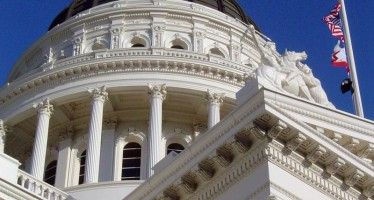High-speed rail workshops will review environmental concerns
 The High-Speed Rail Authority has restarted an aggressive plan to finish the environmental work on the San Francisco to San Jose and the San Jose to Merced segments of the High-Speed Rail Project. Completion of the final environmental documents is planned by the end of 2017. This is in addition to Caltrain’s electrification project, which is a separate process.
The High-Speed Rail Authority has restarted an aggressive plan to finish the environmental work on the San Francisco to San Jose and the San Jose to Merced segments of the High-Speed Rail Project. Completion of the final environmental documents is planned by the end of 2017. This is in addition to Caltrain’s electrification project, which is a separate process.
One workshop was held in San Francisco last week. [See the Palo Alto Online’s account for background information.] The next workshop is planned for this Tuesday, September 15, in San Jose from 4:00 p.m. to 7:00 p.m. at the Roosevelt Community Center. A one hour presentation is planned at 6 p.m. at 901 E. Santa Clara St. San Jose, CA 95116. The Morgan Hill session will be held September 23rd. The last meeting will be held in Burlingame October 7th. The agenda for all workshops will be identical, regardless of location.
As background, at the August 2015 board meeting, the High-Speed Rail Authority approved a Request for Qualifications to be sent out. This RFQ covers both the San Jose to San Francisco segment as well as the San Jose to Merced segment. The consultant chosen will manage the corridor activity conducting “environmental analysis and documentation, regulatory permitting and compliance, engineering and preliminary design services.” Whoever is selected, they are expected to finish the project by December 2017, a very quick process.
Contentious Segments
In the past, both of these segments (San Jose to Merced and San Jose to San Francisco) have been problematic for the Rail Authority. Besides the Peninsula’s vehement opposition to the high-speed rail project, the Merced to San Jose segment, featuring the Chowchilla Wye, was also an area of great contention because of the use of prime farmland and destructive of sensitive environmental areas.
[See the Youtube when Ben Tripousis, Northern California regional director presented the RFQ to the board on August 4, 2015. Here is the document presented at the Rail Authority board meeting.]
Peninsula history
As a reminder, the peninsula’s environmental work stalled for a couple of years due to questions about the joint use of the Caltrain corridor with High-Speed Rail.
This is more commonly known as the blended system first introduced in 2011 by Senator Joe Simitian, Congresswoman Anna Eshoo and Assembly member Rich Gordon, also called the SEG plan. There was extreme unhappiness about the high-speed train coming through the very crowded peninsula area with the real possibility of expansion of the corridor to four tracks.
The SEG plan required no above ground tracks be added to the corridor unless the cities desired that design; and that the high-speed rail plan stay within the current Caltrain footprint. It also required the blended plan be done in one stage. The rail authority had pushed for phased implementation eventually leading to four tracks which is no longer part of the plan today.
Questions of Legality
The high-speed rail board was under the leadership of Curt Pringle in 2011. He and others on the board had mixed emotions about the concept. Questions about the legality of the blended program were sent to the Attorney General’s office twice back in the 2011 by then CEO Roeof van Ark.
This year a public records request was sent to the Rail Authority asking what the result of those inquiries were but they refused to release any AG response, claiming attorney/client privilege.
The question of the legality of the blended system, along with trip time questions and financial viability will be litigated in part two of the Tos/Fukuda/Kings County lawsuit February 2016. [See Tos Trial Brief II on the TRANSDEF website which gives a bit of history about this taxpayers lawsuit.]
In the July 2012 appropriation vote, the state Legislature approved an appropriation of $600 million of Proposition 1A bond funds to Caltrain’s electrification project under the premise that it is a corridor that will eventually operate high-speed rail trains in the future. They also appropriated $500 million for the Los Angeles to Anaheim route though projects were not yet identified for that segment. Neither amount was presented in a funding plan as required in the Prop. 1A ballot measure.
Many, including former Rail Authority Chair Quentin Kopp, have questioned the legality of this appropriation and the idea of the blended system. In a declaration filed for the Tos/Fukuda/Kings County lawsuit, Kopp says he believes “the “track-sharing” arrangement with Caltrain represents one example (Los Angeles to Anaheim represents another) of the Authority’s current alteration of the project from a genuine HSR system.”
Environmental Process
Regardless of that argument, another issue blocking access to the bond funds for the San Francisco to San Jose segment is the non-completion of high-speed rail environmental work required under Prop. 1A on the Peninsula — hence the rush to finish the environmental work described above.
But how they will finish the environmental process is still unclear.
Will the Authority follow the California Environmental Quality Act or use the less stringent National Environmental Protection Act? Or will they use the CEQA process unless challenged in court therefore using the Surface Transportation Board ruling as an “ace in the hole”?
Two years ago, the Surface Transportation Board, a federal agency, exempted the Rail Authority from following CEQA because it is a railroad project under their control. But the end of the story has yet to be written regarding the subject of a CEQA exemption for rail projects as it is expected to be heard, and hotly debate, in the California Supreme Court sometime this year.
There are no American Recovery and Reinvestment Act of 2009 federal grants assigned to the San Francisco to San Jose or the San Jose to Merced segments nor is there private funding available. The project in the Central Valley to the San Fernando Valley currently has at least a $25 billion gap in funding.
Related Articles
Legislators, governor to get 4 percent raise
A state panel approved a 4 percent increase in pay for legislators and statewide elected officers on Wednesday. The average legislator’s
Markets ‘Crush’ Brown's Windmill Fantasy
JULY 29, 2011 By WAYNE LUSVARDI With the swagger of a boxer before a match, on July 24 Gov. Jerry
Brown's Budget Shifts Much To Localities
JAN. 10, 2010 By WAYNE LUSVARDI Gov. Jerry Brown’s budget fix is a topic of statewide social conversation but often



